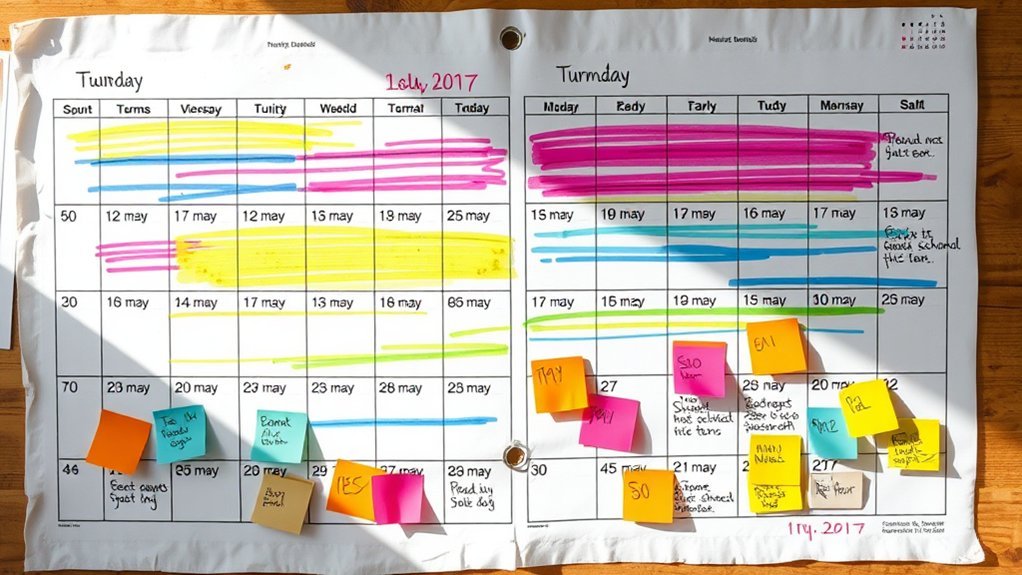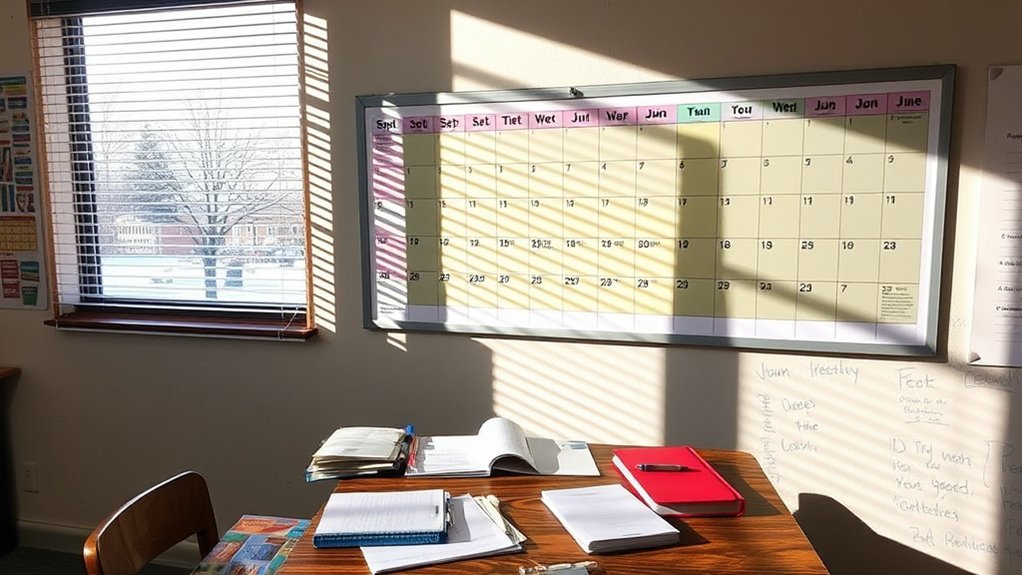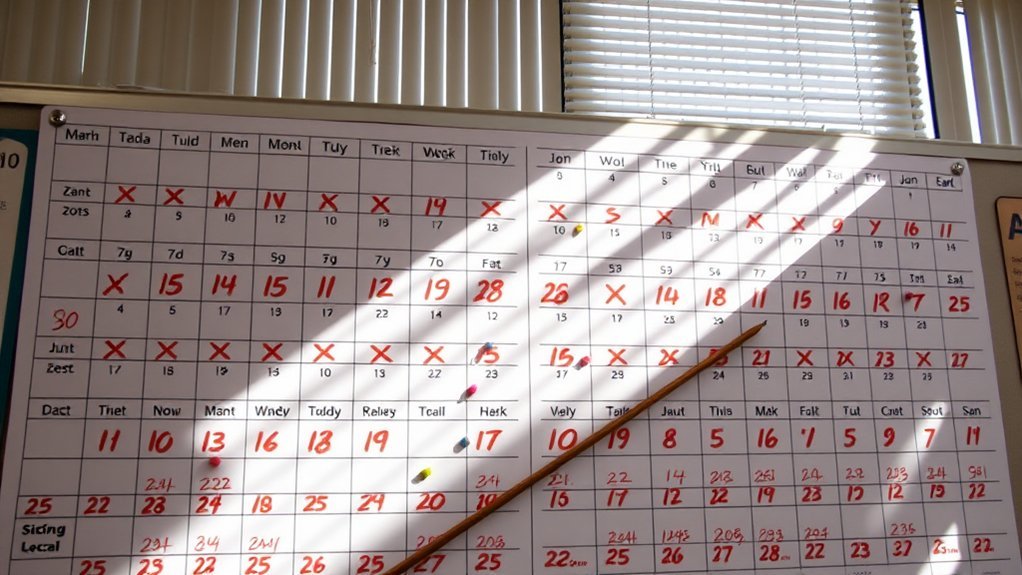How Many Weeks in a School Year
In a typical school year, you can expect around 36 weeks of instructional time, translating to about 180 days of education. However, keep in mind that the actual number of weeks can vary based on breaks and the specific regulations of different states and districts. Some may have shorter or longer years, depending on local policies. There's a lot more to take into account about the academic calendar, so let's explore that further.
Key Takeaways
- A standard school year typically consists of around 180 days of instruction, translating to approximately 36 weeks of instructional time.
- Due to various breaks, actual weeks of instruction may drop to about 26 weeks.
- The average U.S. school year sees approximately 35.65 weeks of instruction after accounting for breaks.
- School year lengths can vary by state, ranging from 170 to 190 school days.
- Year-round schools offer an alternative schedule with more frequent breaks, affecting the total weeks of instruction.
When Does School Start?
When does school actually start for students across the U.S.? The first day of school varies greatly by school district, typically ranging from early August to after Labor Day.
In Texas, some districts kick off the academic year as early as August 7, while others, like Cypress-Fairbanks ISD, begin on August 19. Generally, most Texas school districts start between August 12 and 14.
These start dates often align with local and state regulations, which adds to the diversity of schedules. Understanding this variance helps families plan for the upcoming academic year, ultimately allowing for a smoother change into the school year.
How Many Weeks Are in a School Year?

Understanding how many weeks are in a school year is vital for students, parents, and educators alike, as it directly impacts planning and expectations.
A standard school year typically consists of around 180 days of instruction, equating to about 36 weeks. However, with breaks like Thanksgiving and Christmas, the actual weeks in a school may drop to approximately 26 weeks of instructional time.
On average, the U.S. sees about 35.65 weeks of instruction, varying by state and district. Some areas even have different requirements, ranging from 170 to 190 days.
It's important to know these figures for effective planning.
When Do Schools End?

Have you ever wondered when schools typically wrap up their academic year? Most school districts in the U.S. conclude the school year in the last week of May, although some, like Houston ISD, have their last day on June 4.
This variation often stems from local policies and weather-related cancellations. The final weeks are critical, filled with examinations that can impact students' academic performance.
Variability of School Weeks and Breaks

Although many students might look forward to breaks, the variability in school weeks can considerably influence the overall academic experience. With about six weeks of breaks throughout the year, the total instructional time can diminish. Major breaks like Thanksgiving, Christmas, and Spring Break each take a week, affecting the number of weeks we actually spend in class.
| Break Type | Duration |
|---|---|
| Thanksgiving | 1 week |
| Winter Break | 2 weeks |
| Spring Break | 1 week |
| Total Breaks | 6 weeks |
This leaves roughly 36 weeks of actual instructional time for learning.
Historical Context of the School Year

The origin of the standardized school year can be traced back to the early 20th century, when the need for an educated workforce drove significant educational reforms.
These changes aimed to establish a consistent 180-day academic calendar, moving away from the erratic schedules influenced by agriculture and socio-economic factors.
Origin of School Year
As we explore the origin of the school year, it is essential to recognize how historical shifts shaped today's educational landscape. The standardized 180-day school year emerged in the early 20th century in response to socio-economic needs, particularly to support industrialization. This structure aimed to create a more educated workforce by ensuring consistent schedules for attending school. Below is a table illustrating key historical shifts:
| Year | Change | Impact |
|---|---|---|
| 1800s | Irregular schedules | Limited access to education |
| Early 1900s | Standardized 180-day year | Enhanced educational outcomes |
| 1920s | Structured academic calendar | Improved workforce readiness |
| 1940s | Seasonal breaks implemented | Balanced instructional time |
| 2000s | Continued reforms | Increased focus on educational equity |
Standardization of Instructional Days
While examining the standardization of instructional days, it becomes clear that this framework was essential for establishing an effective educational system.
Established in the early 20th century, the standardized school year of 180 days aimed to respond to socio-economic changes, ensuring a skilled workforce for industrial demands. This duration translates to about 36 weeks of instruction, balancing educational needs with student welfare.
The Department of Education's policies evolved, leading to variations across states, reflecting local priorities.
Ultimately, this standardization provided a consistent structure, fostering both academic growth and community engagement, essential for nurturing informed, capable citizens.
Four-Day School Week in California

I've been exploring the four-day school week model in California, and it raises interesting points about its potential benefits and challenges.
While districts like Leggett Valley and Big Sur Unified have embraced this approach to enhance teacher retention and balance, the impact on academic performance remains up for debate.
As we consider this shift, it's essential to weigh both the advantages and drawbacks it presents for students and educators alike.
Benefits of Four-Day Weeks
The four-day school week, implemented in a limited capacity in California, offers several potential benefits that deserve careful consideration.
One key advantage is improved teacher retention and job satisfaction; educators gain more time for planning and personal commitments.
Additionally, students spend in school the same total hours, often leading to longer days but allowing for frequent breaks that can enhance focus and reduce burnout.
Surveys reflect high approval rates among parents and students, indicating a positive reception.
While some studies suggest mixed academic outcomes, the overall appeal of a four-day schedule is worth exploring further in our evolving educational landscape.
Challenges and Impacts
Implementing a four-day school week in California presents various challenges and impacts that merit close analysis.
While this model aims to enhance flexible learning and improve work-life balance, it's only adopted by two districts due to state regulations that require a minimum five-day week for full funding.
The total number of weeks remains unchanged, yet mixed academic outcomes raise concerns.
Rural students may benefit, but others, particularly in small towns, show decreased performance, especially in reading.
Ongoing debates about its long-term effects and sustainability highlight the complexities of this shift in educational structure.
Balancing costs and academic integrity is essential.
Academic Impact and Concerns

While many schools are adopting a four-day week to enhance work-life balance, concerns about its academic impact are emerging. Research shows mixed results regarding academic achievement, particularly in reading, and students who struggle may face greater hurdles.
| Factor | Impact on Achievement | Notes |
|---|---|---|
| Four-Day Weeks | Mixed | Varies by location and student type |
| Rural Students | Positive | Better performance noted |
| Small Towns/Suburbs | Negative | Struggles more prevalent |
| Extracurriculars | Significant | Can boost engagement and learning |
| Teacher Quality | Critical | Quality influences outcomes |
The debate continues, highlighting the need for further research.
Contact Info

If you're looking to get in touch for more information about the school year structure or any related inquiries, I'm here to help.
Understanding how many weeks are in a school year is essential for planning. Typically, students attend school for about 36 weeks, translating to roughly 180 school days, though some states vary between 170 to 190 days.
Year-round schools alter this structure, offering more frequent breaks.
If you have questions regarding the academic calendar, or need assistance guiding your child's school year, feel free to reach out. I'm committed to providing clear, precise information tailored to your needs.
Frequently Asked Questions
Are There 36 Weeks in a School Year?
I've found that while some might think a school year has 36 weeks, the academic calendar often includes breaks. Education policy varies, leading to an average closer to 35 weeks of actual instruction.
How Long Is a School Year?
When I think about a school year's length, I consider the school calendar. Typically, educational policies dictate about 180 days, translating to roughly 36 weeks, shaping my academic schedule and learning experiences considerably.
How Many Weeks Are in 9 Months of School?
When I look at a school calendar, I see a typical semester breakdown revealing roughly 36 to 40 weeks. Vacation periods can adjust this, but that's generally what students experience throughout the school year.
How Many Weeks Spent per Year in School?
You wouldn't believe how much time we spend in school! With about 36 weeks of school attendance each year, understanding this helps in educational planning and maneuvering the academic calendar effectively. Freedom in learning matters!
Conclusion
To sum up, understanding the school year's structure helps us navigate its complexities. While some might argue that a shorter year limits learning, it's crucial to recognize that quality often trumps quantity. Many schools have adapted to meet educational standards through innovative teaching methods and focused curricula. So, whether your school year spans 36 weeks or 40, what truly matters is how effectively those weeks are utilized. Embracing these variations can lead to a richer educational experience for all students.







